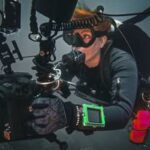Last Updated on April 12, 2024 by Candice Landau
Every now and then it’s good to step outside of the comfort zone of your own well-fitted scuba gear and don the gear your students have to use. Not only does it make you immensely grateful for your own pricey purchases, but it gives you insight into the problems they have to deal with, problems you may forget are real if you’re using gear that works ten times better than theirs.
On Thursday I helped out with a Discover Scuba Diving session for the Boy Scouts of America. Because these students have, for the most part, never tried scuba diving before, none of them own their own equipment. This means they have to make do with what we have available at the time. And while we do have a lot of great gear, given we only have so much of it and have to make best guesses at sizes before we trailer the gear down to the lake near where they camp, sometimes they really do just have to work with what we have.
A poor fitting wetsuit will mean they get cold quickly. A BCD that doesn’t fit right will mean they’re constantly struggling to maintain a position, or to relax. A mask that doesn’t fit will mean water doesn’t stay out. Of all the equipment, an ill-fitted mask is perhaps the most perturbing for a new diver.
While some people are capable of breathing only through their mouths, those that don’t do a lot of swimming haven’t yet learned the skill of blocking the passage between the mouth and the nose. Thus, every time their mask floods with water, they choke, panic and bolt for the surface. The same is true of someone who isn’t used to closing their eyes underwater. Add to that the weight of the gear, and the newness of it all, and you really do have someone who is just going to want to get back to the surface as fast as possible.
This is also the reason the mask clearing skill is the one we most see people struggle with. This happens for all the reasons mentioned above. However, it is made a lot harder when in spite of a good effort to clear a mask, the mask continues to reflood because it doesn’t fit. Add to that a mask that just won’t stop fogging up, and you have a recipe for a less than pleasant session.
On Thursday, one of my students had this exact problem, a mask that was slightly too big and that kept letting water in, even after we’d tightened it. Because we didn’t have a lot of other spare masks, I offered to switch mine for his. I figured that because it was low-volume it would also make the skill easier for him.
Wearing my new mask, he had little problem. He cleared it on his first try and returned to the surface fog free. I was not so lucky. While I was capable of contending with less than a good fit, the constant fogging and the tiny amount of water seeping it, certainly did make it a lot less pleasant. There was nothing I could do about the fog (I’d forgotten my baby shampoo) or the poor fit and I spent the rest of the day wondering how much easier these students would find their intro to the sport if they had really well-fitted gear.
In this way I learned the importance of getting people fitted right from the start, and of carrying a defogger as well as a spare mask, lest problems arise.
And, because I’d opted for a wetsuit over a drysuit on this day, I also realized how much less pleasant the experience is when you start to get cold, and that was in my full-length well-fitted wetsuit. How must these kids feel in shorties, even with their farmer johns?
While we don’t usually have these problems with our open water students (they buy their own masks, fins and snorkel before the first pool session), Discover Scubas are a different ball game.
Moving forward I intend to make sure everyone trying a discover scuba session is kitted out with the best-fitting gear possible, that I am carrying spares as well as anti-fog, and that every so often I put myself in their place and try student gear.

















